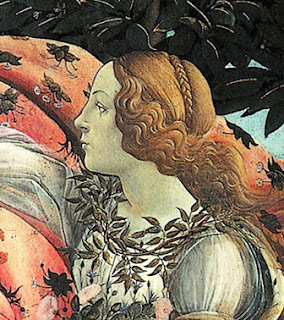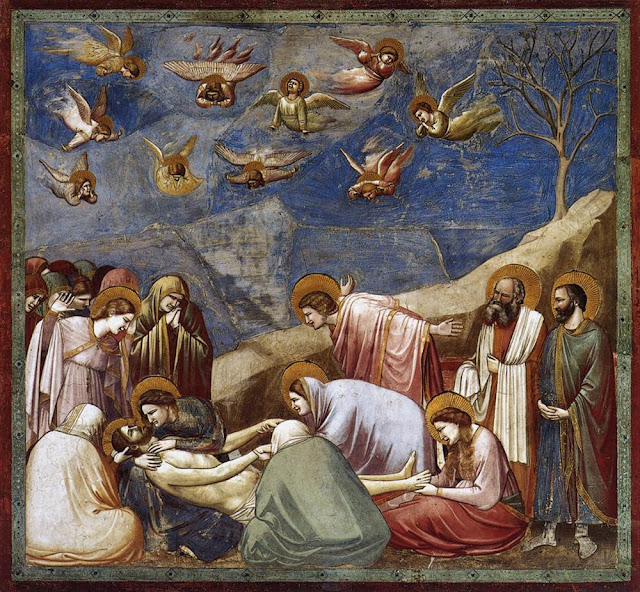Cimbaue and Giotto
Cimabue-“Madonna in Maesta”
- Iconic Painting on treated wooden Panels.
Composition
- Madonna Central and larger sitting on throne. Holding small(adult looking) infant.
- Surrounded by angels. 4 on each side, each mirroring one on the opposite side.
- Painting is Symmetrical.
- Use of Gold leaf and Lapis Lazuli for decorative effect.
Theme/Subject Matter
- Mary enthroned as Queen of Heaven is the subject matter.
- It is a Religious painting.
Treatment of the figure
- The proportions of the figures are reasonably close to life size.
- The treatment of Mary’s clothing is more decorative than it is realistic. Note the use of lines to create patterns in her dress.
- Her hands and face are simplified and do not look real even though they shading is used.
- There are no facial expressions used to convey emotions.
- The angels all look the same, there is no attempt to show individuality.
Shading and Light
- The light on the angels comes from two different sources and does not help to create an illusion of reality.
- The shading on the figures and faces is as more decorative than real.
Decoration
- Nowadays it is hard to look at Cimabues work and appreciate it as a piece of art. It did serve a purpose and did follow the rules laid down for how a religious painting should look.
Giotto-“The Deposition” or “The Lament of Christ”
- Fresco Painting on wet plaster or “Buon Fresco”. Giotto developed the technique of painting on wet plaster, small sections of wall were plastered, the drawing transferred and painted within one day. Prior to this it was common to paint on dry plaster or “Secco”, which although quicker and easier to carry out was not permanent.
Composition
- A more natural composition than Cimabues.
- It shows the scene where Christ has taken down from the cross and is surrounded by his followers. It is set in a natural environment with trees and rocks behind. Above in the sky are the swooping figures of lamenting angels.
- Christ is positioned in the lower left corner and is being cradled by his mother.
- He is being held up by the other women followers.
- Giotto positions the figures to leave a gap through which we can see the dead Christ.
- All the figures are leaning towards and looking at Christ, this helps to lead our own attention to him.
- Another device that Giotto use is the diagonal line of the rock to bring our eyes back to the figure of Christ
Theme/Subject Matter
- It is a Religious painting.
- It shows the moment that Christ was taken down from the cross and his followers are mourning his death.
Treatment of the figure
- The proportions of the figures are realistic and natural looking.
- The figures are modelled using shading and look 3-dimensional. All the figures are based on different characters, no two look alike.
- Lines in the clothing describe the figures underneath.
Shading and Light
Foreshortening
- Giotto uses foreshortening in the figures of his Angels and in the arms of some of his larger figures. He does this to try and maintain the illusion of reality, but also to showcase his understanding of this phenomenon and his skill in showing it.
Expressive works
Giotto captures the moment that Christ was taken down from the cross, he displays the emotion felt by his followers and tries to get us to empathise with them. He broke away from the traditional methods of displaying figures and scenes, his greatest achievement was displaying the emotions of the characters in his work. He is also known as the “grandfather of the renaissance”
Painters and the church returned to the International Gothic as a result of the Black Plague-they thought that the more formal paintings of the Gothic period would be more pleasing to God after he showed his wrath by sending the Plague.
It was almost one hundred years before Masaccio, influenced by the work of Giotto, changed the direction of painting and lead the way for the Renaissance.
Masaccio (1401-1428)-Early Renaissance
Masaccio revived the style that Giotto had first developed 100 years earlier. He created 3-dimensional figures, placed them in a landscape and used perspective to create the illusion of Space. His figures are realistic, solid and have natural looking expressions and gestures. His work inspired many other painters of the Early Renaissance.
"The Tribute Money."
Composition
- We can see three groups of figures placed in a simple background/setting.
- Christ stands in the centre of the main group in his blue robe and red tunic.
- He points to the lake as does St Peter to our Left.
- A tax collector stands in front of the group demanding money, his tunic is bright red and shorter than the rest.
- St Peter can again be seen as a lone figure to the left as he leans down to the water to take money from the mouth of a fish.
- We then can see St Peter on the right giving money into the hand of a resigned tax man.
- In the background we can see mountains which look far away.
Theme/Subject Matter
- This is a religious painting. It tells the story of Christ and the tax collector.
- The tax collector demands money from the apostles. Christ who carries none sends Peter to collect money from a fish in the lake to pay the collector.
Treatment of the figures.
- The figures are all individualistic in appearance.
- They are solid looking and they are strongly modelled in tone to make them look 3-d.
- Most of the figures are all looking inward towards Christ and draw our attention to the action. The all show various types of emotion, but mostly hostility towards the tax collector.
Shading.
- Masaccio uses a single source of light to give the appearance of a natural setting. The lighting on the figures is strong with a big contrast between light and dark.
- The figures cast shadows on the ground to the left.
- There is more shading evident in the building and in the mountains behind.
Colour
- Masaccio uses strong colour in the garments of his figures, almost too much. Christ and Peter are the two figures wearing blue garments. A symbol of Importance.
- The background is muted in contrast to the figures, allowing them to stand out.
I have posted my notes for Sandro Botticelli as promised, there is no need to worry as I will not include him as a question on you Winter Exam paper.
Remember to read through the last two post on the blog here, they will have you questions and scroll further back and you will find the answer. Good luck in you exam.
Sandro Botticelli
- Worked for the Medici Family in Florence.
- He painted both Religious based paintings and Mythological based paintings.
- Two of his better known paintings are;
- “The Birth of Venus”
- “Primeva”
- Was highly sought after during his time.
“The Birth Of Venus"
 |
| Sandro Botticelli-The Birth Of Venus" |
Theme/Subject
- Mythological painting-based on the Birth of Venus.
- Shows Venus as an idealised and beautiful woman, showing what the painters of the Renaissance thought of as ideal beauty.
Composition
- The figures are all in the foreground and fill the surface of the canvas.
- Venus is the central figure is standing on a shell, she is naked and stands in a graceful poses with her weight on one foot.

Zephyrus and Chloris Zephyrus(West Wind) and Chloris(who later becomes Flora) are winged figures who are placed on the left of the painting. They are blowing Venus to the shore.- Flora, the Goddess of flowers is on the shore on the right hand sideholding out a robe to wrap Venus in when she comes to shore.
- The background is very simple, it consists of a sea scape with some land to the right behind Flora.
- The trees behind Flora are more decorative than they are realistic. The leaves on the branches create patterns. This is also the case with the waves on the sea behind the main figures. The waves are placed in a pattern which get smaller as they recede into the background.
Perspective
- Perspective is created through the waves getting smaller as they recede and by the trees which are placed slightly higher up the page
- Perspective as was created by making the shore line diminish/get smaller to make it seem its in the distance.
 |
| Detail of Venus |
Colour, Tone and Pattern.
- It is oil on Canvas
- Colour in the painting is realistic. The brightest colour is the rusty red of the cloak that Flora holds open for Venus.
- Gold leaf is used as a means of highlighting the hair and wings of the figures, it is also used to highlight the leaves.
- The figures are modelled in subtle flesh tones, creating rounded, sensuous bodies.
- Pattern is important to Botticelli, he uses it to create a sense of harmony and movement.
- Patterns are seen in the cloaks of the figures on the left, in the folds of Flora’s cloak, in the hair of all the figures. This is a technique that was widely used in the Gothic period.
 |
| Flora originally Chloris |
Treatment of Figures
- The figures are all realistically moddelled in tone giving a natural feel.
- He has composed the figures in the foreground filling the work.
- The figures are arranged in fluid, graceful poses.
- Venus stands with her weight on one foot which creates and “S” in her figure. This was an influence from classical Greek and Roman sculpture.
- Botticelli’s depiction of women idealises the Renaissance idea of Female beauty and grace.
- Her limbs look soft and fleshy.
- The position of her hands and fingers are relaxed and graceful.
- Her neck is elongated to show grace and beauty.
Second work by Botticelli - Primavera.
 |
| "Primavera" Botticelli |
- This is a Mythological Painting.
- Painted Oil on Wood.
- “Primavera” means Spring
- It shows Venus her son Cupid, Chloris and Flora, the Three Graces (Venus’ hand maidens), Mercury (messenger of the Gods) and Zephyrus.
- All the figures are composed/arranged to the front of the painting.
- The figures are all subtly modelled in tone.
- The figures are in curving slender poses.
- The paintwork is highly finished.
- Colours are subtle.
- The background is patterned showing a decorative Gothic influence.
- Venus stands out in contrast to the dark background placed behind her.
Last Word
Botticelli broke away from the tradition of Religious paintings when he chose to paint “The Birth of Venus”, which was probably painted for a member of the Wealthy Medici Family. Most of his work was commissioned by powerful patrons and he did also paint Religious scenes. The Medici family were eventually thrown out of Florence and Botticelli did fall out of fashion in his own lifetime, he died in poverty. He work was rediscovered in the 19th C.
Botticelli broke away from the tradition of Religious paintings when he chose to paint “The Birth of Venus”, which was probably painted for a member of the Wealthy Medici Family. Most of his work was commissioned by powerful patrons and he did also paint Religious scenes. The Medici family were eventually thrown out of Florence and Botticelli did fall out of fashion in his own lifetime, he died in poverty. He work was rediscovered in the 19th C.






No comments:
Post a Comment